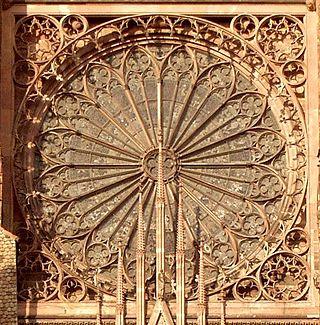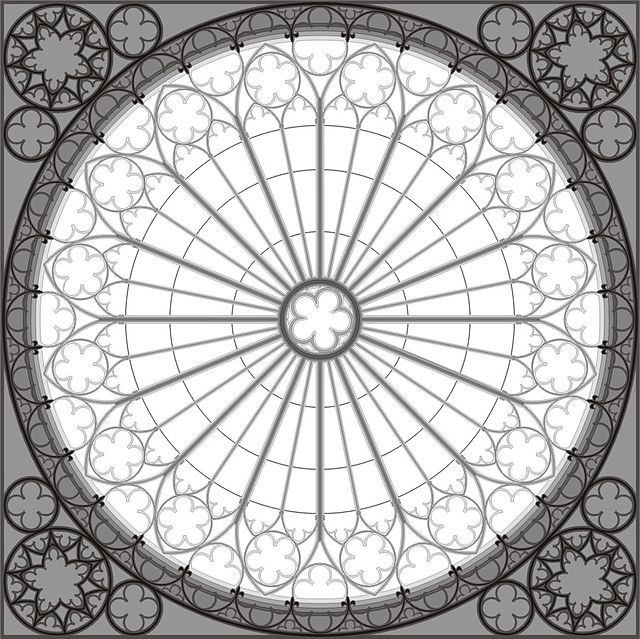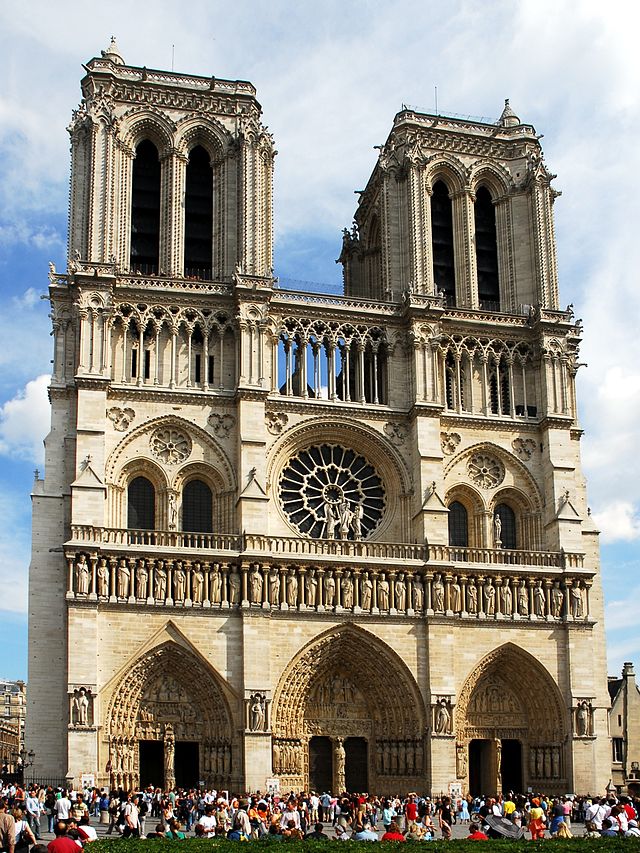Loading AI tools
Circular window found in Gothic churches From Wikipedia, the free encyclopedia
Rose window is often used as a generic term applied to a circular window, but is especially used for those found in Gothic cathedrals and churches. The windows are divided into segments by stone mullions and tracery. The term rose window was not used before the 17th century and comes from the English flower name rose.[1]



The name "wheel window" is often applied to a window divided by simple spokes radiating from a central boss or opening, while the term "rose window" is reserved for those windows, sometimes of a highly complex design, which can be seen to bear similarity to a multi-petalled rose. Rose windows are also called "Catherine windows" after Saint Catherine of Alexandria, who was sentenced to be executed on a spiked breaking wheel. A circular window without tracery such as are found in many Italian churches, is referred to as an ocular window or oculus.
Rose windows are particularly characteristic of Gothic architecture and may be seen in all the major Gothic cathedrals of Northern France. Their origins are much earlier than Gothic architecture, however, and rose windows may be seen in various forms throughout the Medieval period. Their popularity was revived, with other medieval features, during the Gothic revival of the 19th century, so that they are seen in Christian churches all over the world.[2]
The origin of the rose window may be found in the Roman oculus. These large circular openings let in both light and air, the best known being that at the top of the dome of the Pantheon. Geometrical patterns similar to those in rose windows occur in Roman mosaics.
The German art historian Otto von Simson considered that the origin of the rose window lay in a window with the six-lobed rosettes and octagon which adorned the external wall of the Umayyad palace Khirbat al-Mafjar built in Jordan between 740 and 750 CE. This theory suggests that crusaders brought the design of this attractive window to Europe, introducing it to churches. But the decorative pattern for rose and, independently, the tracery, are very present in vestiges of the early Christian architecture, Byzantine architecture, and especially in Merovingian art, and Visigothic architecture before the Muslim conquest of Spain. But half roses are also known, as with the church of San Juan Bautista in Baños de Cerrato. The scarcity and the brittleness of the vestiges of this time does not make it possible to say that complete rose window in tracery did not exist in early Middle Ages.
In Early Christian and Byzantine architecture, there are examples of the use of circular oculi. They usually occur either around the drum of a dome, as at the Church of the Holy Sepulchre, Jerusalem, or high in the end of a gable of low-pitched Classical pediment form, as at Sant'Agnese fuori le mura, Rome, and Torcello Cathedral.[12]
A window of the 8th century, now in Venice, and carved from a single slab, has alternating tracery-like components of two tiers of four lancets separated by three oculi. Many semicircular windows with pierced tracery exist from the 6th to the 8th century, and later in Greece.[13]
Small circular windows such as that at S. Agnese and Torcello as well as unglazed decorative circular recesses continued to be used in churches in Italy, gaining increasing popularity in the later Romanesque period.
In the vicinity of Oviedo in Spain are several churches of the late 9th and early 10th century which display a remarkable array of windows containing the earliest examples of roses windows outside the Byzantine Empire. The designs closely resemble the motifs found on the Byzantine relief carvings of marble sarcophagi, pulpits and well heads and pierced decorations of screens and windows of Ravenna and Constantinople. The church of San Pedro has a rectangular window with a pierced decoration of two overlapping circles, the upper containing a Greek Cross, the window being divided by the circles and the arms of the cross into numerous sections like tracery "lights".
In another of these churches, San Miguel de Lillo, is the earliest known example of an axially placed oculus with tracery. Several such windows of different sizes exist, and decoration of both Greek Cross and scalloped petal-like form occur, prefiguring both wheel and rose windows.
Circular windows and decorative circular recesses are a feature of many Romanesque churches and cathedrals, particularly in Germany and Italy where the style existed for a prolonged period, overlapping the development of Gothic in France and its arrival with French architects in England.
In Germany, Worms Cathedral, has wheel windows in the pedimental ends of its nave and gables, very similar to the Early Christian Basilica of S. Agnese in Rome. The apsidal western end has a central wheel window with smaller oculi in each face. The Church of the Apostles, Cologne has an array of both ocular and lobed windows forming decorative features in the gables and beneath the Rhenish helm spire. The octagonal dome has a ring of oculi with two in each of the curved faces.[13]

In Třebíč, Czech Republic, is the 12th- and 13th-century Romanesque style Basilica of St Procopius with apsidal windows similar to those at Worms, but in this case the openings are filled with tracery of a Gothic form, clearly marking the transition to a new style.
In Italy, the use of circular motifs in various media was a feature of church facades, occurring on Early Christian, Romanesque, Gothic, Renaissance and Baroque churches, a well-known example being those great circles in polychrome marble which complement the central circular window on Alberti's Early Renaissance façade at Santa Maria Novella in Florence.[14] Oculi were also typically used in the drums supporting domes and as upper lights in octagonal baptisteries such as that at Cremona.
Romanesque facades with oculi include San Miniato al Monte, Florence, 11th century, San Michele, Pavia, c. 1117, and Pistoia Cathedral, 1150. As the windows increased in size in the later Romanesque period, wheel windows became a standard feature of which there are fine examples at San Zeno Maggiore, Verona and Monza Cathedral.[13]
On the Romanesque façade of Spoleto Cathedral there is a profusion of recessed and traceried oculi surrounding the central features of a rose window set within a square beneath a large mosaic of 1207.
In England there exist five Romanesque wheel windows, notably those at Barfreston and Castle Hedingham parish churches.


The transition from the Romanesque style to the Gothic was not clear cut, even at the Abbey of St Denis, to the north of Paris, where the Abbot Suger, between 1130 and 1144, gathered the various newly emerging features of Gothic into a single building, thereby “creating” the Gothic style.[15]
Suger's original rose window in the prototype Gothic façade of St Denis probably pre-dates many of the remaining circular windows in Romanesque buildings such as those in England, at Trebic and Spoleto and that in the façade at Speyer.
Suger's window was not distinctively Gothic in its appearance. It no longer has its original form, but a mid-19th-century drawing by the restorer Viollet-le-Duc indicates that it had a very large ocular space at the centre, the glass supported by an iron hoop, and surrounded by simple semicircular cusped lobes cut out of flat stone in a technique known as "plate tracery". The window now has Gothic tracery in it, possibly added by Viollet-le-Duc who was very concerned about the lack of stability of the whole façade, and having restored the towers, was impelled to demolish the northern one when it suddenly subsided.
Along with the simple wheel windows of the late Norman period in England, Germany and Italy, a large late 12th-century window still exists at Chartres Cathedral. This remarkable window combines a large roundel at the centre with the radiating spokes of a wheel window, surrounded by a ring of smaller “plate tracery” lights with scalloped borders. The window, depicting the Last Judgement, contains its original scheme of glazing and retains much of the original glass of 1215, despite suffering damage during World War II.[16]
Following the west window of Chartres, more daring Gothic windows were created at the Collegiate Church of Notre-Dame in Mantes and in the dynamically sculptural facade of Laon Cathedral (which also, unusually, has a rose window in its eastern end as well as in it transept ends). These windows have large lights contained in tracery of a semicircular form, like overlapping petals.

The window that is central to the well-known Gothic façade of Notre Dame, Paris, is of more distinctly Gothic appearance, with mullions in two bands radiating from a central roundel, each terminating in pointed arches. It was this window, completed about 1255, that set the pattern for many other rose window including those of the transepts at St Denis and the gigantic and complex window in the south transept at Notre Dame.[17]
At Chartres, the transepts roses follow the style of the original 12th-century rose, elaborating on the theme of contrasting forms. The south rose combines the wheel with circles and semicircles, while the north rose introduces square lights which, rotating around the centre, are all set at different angles, creating a kaleidoscopic effect of great energy.[18]
From the building of Chartres the dimensions of the rose window began to increase with the development of more elaborate window styles associated with Gothic architecture. By the middle of the 13th century the rose had attained the greatest possible size – the entire width of the nave or transept, as seen in the transept roses at St Denis and Paris.
In the facades of St Denis, Chartres, Mantes, Laon and Paris, the rose was put under a circular arch. The next important development in its use for the Gothic style was to put it under a pointed arch, as was done in the Notre-Dame de Reims (after 1241), in the transepts as well as in the later roses of the facade. This form probably stemmed from the now destroyed St Nicaise, also in Reims.
The rose window was often placed above a row of vertical lights as the apex of the composition, the small corner "spandrels" between the rose and lower tier being filled by smaller lights of rose form, as in the transepts of St Denis and Notre Dame.
The last step in evolution of the Gothic style was to set the rose into a tier of vertical lights, of staggered height and surmount it by a tapering pointed light so that it became the centre of a vast window composition, covering the whole end of the transepts, as in Rouen or Beauvais Cathedrals. This sort of elaborate composition can also be seen at the east end of Milan Cathedral.
Rose windows were also set into square windows, the spandrels being pierced and filled with smaller lights as at Paris, 1257, or unpierced with sculpture, the form more common in Italy as at Spoleto and also seen in the north transept of Westminster Abbey and at Strasbourg Cathedral, (see pictured above).
A number of Australia's cathedrals have Gothic Revival rose windows including three by William Wardell at St Mary's Cathedral, Sydney and another at St Patrick's Cathedral, Melbourne which form the upper part of a very large seven-light window in the west end.
Two examples of rose windows are found in the National Basilica, built in 1893 and in the Santa Teresa Church, built in 1934. The cathedral in Cuenca, in the southern Andes, has a notable rose window.

In England, the use of the rose window was commonly confined to the transepts although roses of great span were constructed in the west front of Byland Abbey and in the east front of Old St. Paul's Cathedral in London.
The cathedrals of York, Lincoln, Canterbury, Durham and Oxford feature medieval rose windows.
Medieval Beverley Minster has an example of an Early Gothic wheel window with ten spokes, each light terminating in a cusped trefoils and surrounded by decorative plate tracery.
Later windows are to be seen at the nondenominational Abney Park Chapel in London designed in 1838–40 by William Hosking FSA; Holy Trinity Church, Barnes, London; St Nicholas, Richmond; and St Albans Cathedral by George Gilbert Scott.
At Christ Church Appleton-le-Moors, Yorkshire, the 19th-century architect J.L.Pearson appears to have taken as his inspiration the regional floral symbol of the white rose. This unusual plate-tracery window dating from the 1860s has been designed with five double sections like the two-part petals of a simple rose.
The largest rose window in England is believed to be that installed in the chapel of Lancing College in 1978, with a diameter of 32 feet.[citation needed]
France has a great number of medieval rose windows, many containing ancient glass. In northern France, a rose window is usually the central feature of the facade. The transept facades commonly contain rose windows as well. Examples can be seen at Notre Dame, Paris (see left), the Basilica of Saint Denis (see left), Chartres Cathedral (see above), Reims Cathedral, Amiens Cathedral and Strasbourg Cathedral (see introductory pictures.)
In Italy, the rose window was particularly used by the Lombard architects, as in San Zeno in Verona, and in the Cathedral of Modena, and in the Tuscan Gothic churches like the Cathedrals of Siena and Orvieto. An outstanding example of a rose window is the thirteen-spoked centrepiece of the Minor Basilica in Larino, Molise (1312). Others are the Basilica of St Francis of Assisi and Santa Maria di Collemaggio (1289) in L'Aquila.
First United Methodist Church in Lubbock, Texas, houses one of the largest rose windows at 26+1⁄2 feet (8.1 m) in diameter.[19] A Baroque oculus without tracery or stained glass can be seen at San Jose Mission in San Antonio, Texas, which was founded by the Franciscan Fathers and dates from 1718 to 1731.
The largest rose window in the United States is The Great Rose Window above the main doors of the Cathedral of St. John the Divine in New York City. It is designed in the Gothic Revival style and made from more than 10,000 pieces of stained glass.
Washington National Cathedral has three large rose windows which represent the Creation, Last Judgement, and Glory of God.
In 1954, the French artist Henri Matisse created the Abby Aldrich Rockefeller Memorial Rose Window on the east wall of the Union Church of Pocantico Hills, New York.


In Gothic cathedrals and churches, where a rose is often found above the West Door, the most common subject of the stained glass that it contains is the Last Judgement, which by a long tradition is depicted either in mural or glass on the western wall of the building.[20] In such windows Christ is shown seated in the centre "light" and within the lights around him are the symbols of the four Gospel writers, Apostles, Prophets, Saints and Angels. Some windows show God's dominion over Heaven and Earth by including Zodiacal signs and Labours of the Months.[21]
When rose windows are used in the transept ends, then one of those windows is frequently dedicated to Mary as the Mother of Jesus. In modern Catholic thought, the rose window is often associated with the Virgin Mary because one of her titles, referred to by St Bernard of Clairvaux, is the "Mystical Rose". However, the specific association of Mary with the rose window is unlikely during the Medieval period, because the term "rose window" was not coined until the 17th century, a time when few such windows were being constructed. However, with the revival of the Gothic style in the 19th and 20th centuries, much stained glass that was installed in rose windows, both in new churches and as restoration in old churches, was dedicated to the Virgin Mary.[22]
This section may need to be rewritten to comply with Wikipedia's quality standards. (December 2017) |
Note: The styles below refer to the architectural advancements that occurred in the evolution of the Rose window.
Seamless Wikipedia browsing. On steroids.
Every time you click a link to Wikipedia, Wiktionary or Wikiquote in your browser's search results, it will show the modern Wikiwand interface.
Wikiwand extension is a five stars, simple, with minimum permission required to keep your browsing private, safe and transparent.